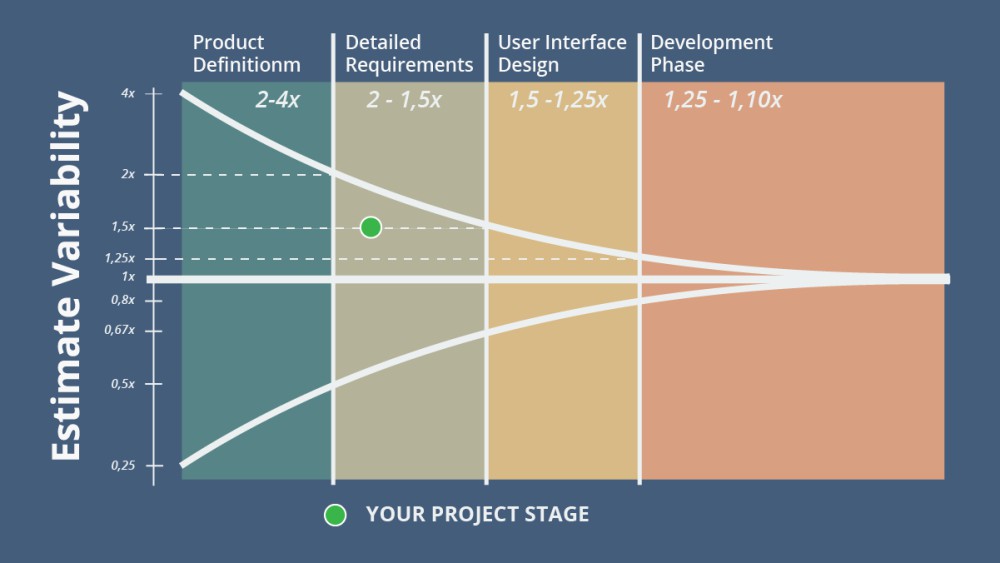Let’s start with the inevitable first: identify the industry that you’ll be operating in and study (or ask a professional) the laws that you will have to abide by. Consider the GDPR, for example, which is in effect all across the EU. Fail to comply with some of their regulations, and you’re already liable to be fined for €20.000.000 or as much as 4% of your yearly turnover. Also keep in mind that most non-EU countries have similar regulations or are in in the process of setting them up.
Then, when you start to budget your application’s development, know that the general price range of engineering is about €40 – €75 per hour, depending on the type of technology required and the team’s experience. Moreover, if your concept involves some aspect of AI or machine learning, the prices might go up even further, for this technology is complex and the pool of developers limited.
-
1Envision your application and start writing out every step that is involved in using it. At this stage, try to think how your end-users would use your product and write your instructions accordingly.
-
2Next, consider your operations team and think of how they would operate your application. Put all those instructions on paper as well.
-
3Think of what you application exactly adds, what is your Unique Selling Point (USP)?
Which (daily) processes could your app facilitate or make easier? How would that work exactly? Be thorough!
-
4Think of the 3rd party software that you would like to make use of (Google, social media, payment systems, etc.) and check whether they already have an API connection.
Are you done with these steps and do you have all your app’s requirements listed on paper? Then it’s time to start sketching the interface of your application. Write down what each button does, and go through all the different screens that end-users would see.
Time to decide: MVP or Complete Application?
Unless you already have experience with the development of an application or if money isn’t your primary constrain, you probably want to build a Minimum Viable Product (MVP) first. Besides saving a ton of development money, an MVP forces you to narrow down your application’s primary purpose and validate whether your target group is actually interested in this.
With your MVP, you will have a tangible prototype that you can convince potential investors with, attract early adopters with, and get real user feedback on. In effect, you will get the chance to understand what your target group likes, and how you can mold your app according to their wishes.
Did you opt for a complete application right away? Then it’s still smart to test your User Experience (UX) before you start developing. For this, it’s best to build a more elaborate prototype and search for a trial audience that can provide you with feedback. This process alone could cost as much as 400 workhours, after which you’ll still need about 600-800 hours for editing and designing the final User Interface (UI) of your application. If you already have your MVP, you can reduce these hours by as much as 600 since you’ll already have a clear picture of what your users want.
Ready for Front-End development? Budget up to 200% of your UX costs
Although no one wants to hear this, it’s an important element to consider when you budget your app. This is the stage where you’ll truly see and experience what your final application will look like. This is the point where you’ll choose sliders, buttons, animations, graphs, and all other kinds of eye-pleasing elements. Whether something is “good” at this stage is very subjective and in order to feel that it is often costs more revisions rounds than you would like it to take.
Backend and API development: The most expensive parts
In order for your application to function correctly, and to be able to continue evolving it, it’s important that your app has a well-written codebase. Although this is the part that’s “under the hood” of your application – and thus something your end-users will never see – it’s what they’ll experience when using your app and what they’ll be frustrated with if it fails them.
The API (Application Programming Interface) makes sure that your end-users will see the right options and information at the right time. A dashboard (which is powered by an API), for example, provides you with an overview of usage statistics, and allows you to enable services or change in-app settings for end-users.
Quotations and Estimates: How to interpret them?
If you don’t have your own development team ready at hand, it’s important to discuss your project with different IT agencies. Subsequently, make sure to ask all these agencies for a quotation and ask them in how far these take error margins into account.

As a rule, be suspicious about anything that’s quoted up to 1.000 workhours for a complete application. This is simply too little to build a proper product and will either come back at you by limiting your app’s scalability or in the form of excessive maintenance costs. The latter, you should ask about as well, for maintenance shouldn’t cost you yearly more than 20-30% of the total development price.
Although MVP’s are kind of there to develop something cheap, good, and fast, you’ll always have to pick 2 out of these 3 for a complete application. Since you should never compromise on the quality of your app, you have to consider for yourself whether time or money is the limiting factor for your project.
Conclusion
Done with you development budgeting? Then don’t forget that deploying your app will involve some costs as well. For iOS this is €100 per year, for Android €25 once, and the hosting costs of your API and web product vary from provider to provider. Although it’s not the largest sum, this total could range from €3.000 to €5.000 per year.
In total, then, MVP’s could be developed for as little as €15.000 (excl. deployment and hosting), while complete applications (depending on their complexity) start at roughly €40.000 but could easily run up to €140.000.
Finally, always budget for the highest estimated figure, because an incomplete app will never generate a single buck of revenue. If you end up with some change in your pocket after your app is done, you’ll have something spare for the inevitable maintenance costs or an opportunity to kick start your marketing campaign and make your app known to the public.
Start with your own app now!
Looking for online success?
We are curious to hear your story! What does your organization do, and what is your mission?
We love to look at how you can achieve (even more) online success, and how we can help you realise this.

